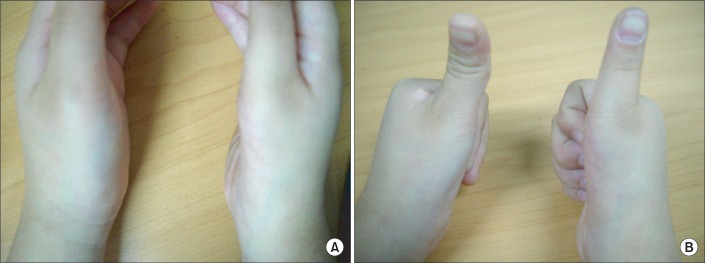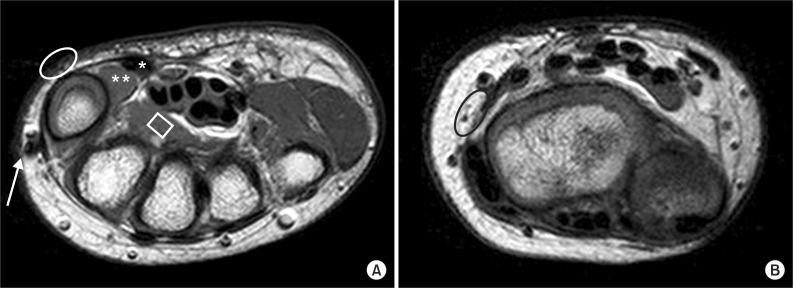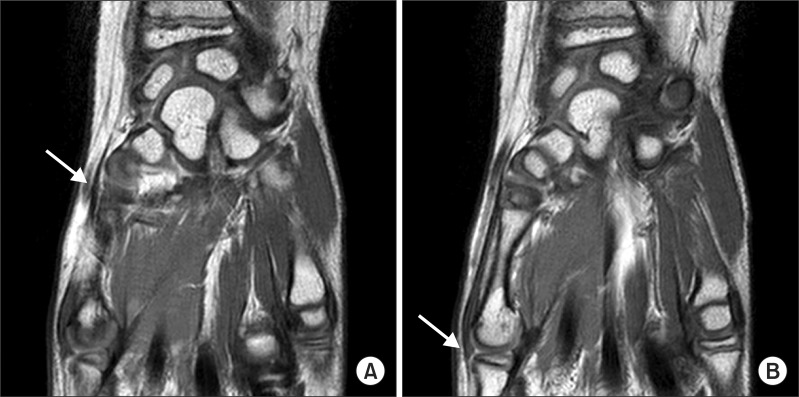Ann Rehabil Med.
2013 Feb;37(1):151-155. 10.5535/arm.2013.37.1.151.
Anomalous Course of the Extensor Pollicis Longus With Multiple Absences of Thumb Muscles
- Affiliations
-
- 1Department of Physical Medicine & Rehabilitation, Chung-Ang University College of Medicine, Seoul, Korea. donkim21@gmail.com
- KMID: 2266666
- DOI: http://doi.org/10.5535/arm.2013.37.1.151
Abstract
- We report a rare case of a 10-year-old girl with anomalous course of extensor pollicis longus (EPL) muscle, which exists with absence of thenar muscles and muscles in the 1st extensor compartment. Her chief complaint was severe atrophy on the right thenar eminence. On physical examination, there was no obvious functional abnormality on her right thumb. On magnetic resonance imaging, we found that the abductor pollicis brevis, opponens pollicis, abductor pollicis longus, and extensor pollicis brevis muscles were absent. The tendon of the EPL muscle was found, but it had abnormal insertion on the radial side of the proximal phalanx, not on the distal phalanx. This variation was thought to have played a major role in compensating for impaired abduction of the thumb, which is usually accompanied by agenesis of major abductors of the thumb.
Keyword
MeSH Terms
Figure
Reference
-
1. Shiraishi N, Matsumura G. Anatomical variations of the extensor pollicis brevis tendon and abductor pollicis longus tendon: relation to tenosynovectomy. Okajimas Folia Anat Jpn. 2005; 82:25–29. PMID: 15934601.2. Fernandez D, Gupta S, Fallon P. Congenital thenar hypoplasia with absent radial artery: a case report. Eur J Paediatr Neurol. 2009; 13:277–279. PMID: 18571945.3. Su CT, Hoopes JE, Daniel R. Congenital absence of the thenar muscles innervated by the median nerve: report of a case. J Bone Joint Surg Am. 1972; 54:1087–1090. PMID: 5057104.4. Jackson WT, Viegas SF, Coon TM, Stimpson KD, Frogameni AD, Simpson JM. Anatomical variations in the first extensor compartment of the wrist: a clinical and anatomical study. J Bone Joint Surg Am. 1986; 68:923–926. PMID: 3733780.
Article5. Yoshida Y. Anatomical study on the extensor digitorum profundus muscle in the Japanese. Okajimas Folia Anat Jpn. 1990; 66:339–353. PMID: 2336244.
Article6. Rubin G, Wolovelsky A, Rinott M, Rozen N. Anomalous course of the extensor pollicis longus: clinical relevance. Ann Plast Surg. 2011; 67:489–492. PMID: 21407056.7. Gupta S, Michelsen-Jost H. Anatomy and function of the thenar muscles. Hand Clin. 2012; 28:1–7. PMID: 22117918.
Article8. Ogino T, Ishii S. Opponensplasty by abductor digiti minimi for hypoplastic thumb. Orthop Traumatol. 1995; 4:29–36.
Article
- Full Text Links
- Actions
-
Cited
- CITED
-
- Close
- Share
- Similar articles
-
- A Variant Extensor Pollicis Brevis Crossing the Anatomical Snuff Box
- Variations of Insertions of the Abductor Pollicis Longus and the Extensor Pollicis Brevis in Korean
- Traumatic Buttonhole Deformity of the Thumb
- Traumatic Rupture of the Extensor Pollicis Longus Tendon Associated with Smiths Fracture: A case report
- Accessory extensor pollicis longus as a rare radial-sided tendon anomaly: a case report




